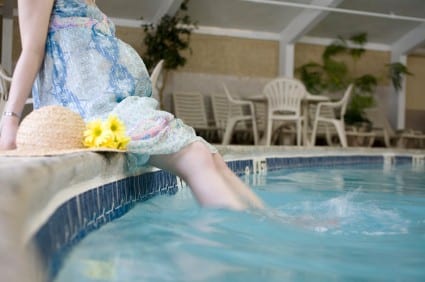The labor and delivery options available to pregnant women have increased during the last several decades, according to the American Pregnancy Association. One of the most recent birthing methods developed is the water birth. During a water birth, the mother undergoes much of her labor in a large tub of warm water and, if she wishes, can deliver the baby while in the water. The option is gaining popularity in many hospitals and birthing centers; proponents say that this sort of delivery has many benefits for both the mother and the baby.
Aspects
Most modern water births take place in a special birthing pool, an inflatable pool filled with water that, as Waterbirth International reports, is kept between 95 and 100 degrees F. These pools may already be in place at some birthing centers and hospitals, but they can also be rented for use at home or at medical institutions that do not already provide the pools. Most advocates of water birth, including Waterbirth International, strongly recommend that women interested in this birthing option avoid trying to use normal bathtubs or small children’s pools since these are much more difficult to maintain the proper temperature in and don’t allow enough room for the birth attendant to monitor the delivery. The Pregnancy Info website adds that birthing pools must be at least 20 inches deep to provide enough buoyant support for the mother. A laboring woman using the water birth technique is generally encouraged to use the pool whenever she is comfortable in it; however, immersing in the water too early in labor can often slow contractions down. The Waterbirth website says that, for this reason, some birth attendants begin offering the pool as an option during labor only after contractions are strong and regular.
Process
If you’re interested in a water birth, the American Pregnancy website recommends that you first check with your health care provider to determine if any covered hospitals or birth centers in your area are already equipped with permanent birthing pool facilities. If none are available, check for local companies that rent birthing pools and find out if the facility where you will be having the baby allows a water birth option. While some insurance companies cover the cost of a birthing pool rental, others do not; be certain to contact the company and find out their specific policies. In addition, you will want to have an attendant present at the delivery that has experience with water births. Many birth centers can provide lists of possible midwives, doulas or water birth-friendly physicians and nurses.
Benefits
Supporters of water birth say that this birthing option helps relax the laboring mother and assists in alleviating the pain of delivery and labor through a combination of increased blood circulation to the uterus stimulated by the buoyancy of the water and a decrease in the production of stress hormones. Water births help prevent anxiety-related spikes in blood pressure and, since water-soaked skin has greater elasticity, they decrease the likelihood of severe tearing and the need for stitches or an episiotomy. Water birth advocates believe water birthing to be beneficial to the newborn baby, because being delivered into the water eases the baby’s transition from the amniotic fluid-filled uterus to the outside world. Proponents of the technique say there is no danger that the baby will breathe in water since she will not begin to use her lungs until she is brought into the air within the first 10 seconds after birth.
Drawbacks
The American Pregnancy website reports that while the "British Medical Journal" is largely in favor of water births as a safe delivery option, in a 1999 article, researchers expressed concern that, in the event of a complicated delivery in which the umbilical cord becomes knotted or compressed, the baby might begin to gasp and suck water into their lungs. A 2002 study and follow-up article in the medical journal "Pediatrics" concluded that water births can increase the chance of a newborn drowning, developing pneumonia or infections and having oxygen deprivation-related seizures. The Live Science website adds that water births are not recommended by the American College of Obstetricians and Gynecologists as a viable birthing option.
Risks
Women with certain medical conditions or complicated pregnancies should avoid trying to deliver with a water birth. These include women with herpes or high blood pressure, women who have experienced unexpected hemorrhaging during the course of the pregnancy and women who are either having more than one baby or have a baby in the breech position. In addition, water birth isn’t recommended for women who go into premature labor.





